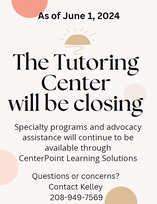 For the past three school years we have been blessed to serve the communities that surround us. During that time our tutors have worked with more than 75 students providing specific academic support. As of June 1, 2024, Empowering Minds - The Tutoring Center will be closing the doors to 1:1 tutoring in our current center format. Private tutoring will still be available to interested families. A list of tutors and their contact information is provided below. Empowering Minds - CenterPoint Learning Solutions will remain in business. Kelley will continue providing specific learning programs for dyslexia, attention, and other academic/social struggles, educational consulting and advocacy services, parenting classes and community training. For questions or concerns please feel free to reach out to Kelley directly at 208-949-7569.
0 Comments
We are quickly approaching the end of the third quarter of school and parents will soon be headed into Parent-Teacher Conferences. Parents, remember, you are your child’s first advocate. Some children with learning differences go undetected for years because they “aren’t failing bad enough.”
It is a common occurrence in today's school setting where students languish in the RTI system making just enough change to show improvement, but not enough progress to keep up with their peers. Each year the child falls more and more behind. These situations often leave parents, and teachers, feeling helpless. Parents hear this loud and clear – YOU HAVE POWER and you need to use it!
I strongly encourage you to find other parents who share your concerns. Band together and you can make a difference. Remember you are not alone. If you have questions, reach out for a consultation. At CenterPoint Learning Solutions we provide support for reading, attention, executive functioning and math, as well as parent advocacy. As we begin the new year, many students are also beginning a new semester. With the new semester comes new challenges, or bigger challenges built upon the failings of the previous semester.
All people need executive functioning skills – but many individuals struggle to understand and develop the underlying foundation needed to establish efficient executive functions. The following is a quick list of what “executive functioning” looks like for a student.
If your child struggles in these areas, support is needed and available from The Tutoring Center.  Jack and Jill - Little Jack Horner - Three Blind Mice - what do they have in common? They are all nursery rhymes which started out as SONGS! That is right, nursery rhymes are actually songs. So many children today are not familiar with nursery rhymes! When my children were young, we listened to fun nursery rhyme songs whenever we were in the car and we sang them around the house. The lilting, silly, fun word-play taught my children rhyme and cantor. Little did I know that our fun and play was rooted in science. According to a recent study from Cambridge University, "Parents should speak to their babies using sing-song speech, like nursery rhymes, as soon as possible...because babies learn languages from rhythmic information, not phonetic information, in their first few months." In my simplistic explanation, sing-song-singing leads to hearing word parts (morphemes), which leads to hearing individual sounds (phonemes), which greatly assists children in learning phonics. "The study sheds light on language learning and its relation to dyslexia and developmental language disorders. Key Facts:
 October – the month of harvest and Halloween…and PARENT-TEACHER CONFERENCES!! Many schools have just completed this fall ritual and many parents have returned home concerned with their child(ren)’s lack of progress in the first quarter of the school year. It is very appropriate that the month of October has also been designated as DSYLEXIA AWARENESS and Attention Deficit (ADHD) AWARENESS Month! At the beginning of this school year, kindergarten – 5th grade students in the state of Idaho participated in screening for dyslexia. Students were identified as exhibiting characteristics of dyslexia if they scored below standard in one or more of the following essential areas of reading: • Phonological awareness • Alphabet knowledge • Decoding skills (reading) • Encoding skills (spelling) • Vocabulary • Comprehension • Text fluency (fluidly reading) Many parents, for the first time, became aware that their child’s “slow reading” skills has a name! DYSLEXIA Historically, when students struggle to read at grade level, schools provide some form of intervention, which parents may or may not know about. In the past, parents may not have been aware of their child’s continued struggle in literacy past third grade because subject area grades are not an accurate measure of a student’s reading ability. Now, in the state of Idaho, parents of students who have been identified as exhibiting difficulty in the areas noted above, are required to be informed and the school is required to provide intensive intervention addressing these deficit areas. Some may wonder, are these the ONLY characteristics of a potential learning struggle and the answer to this is NO! The above areas are specific to literacy, but dyslexia effects much more than just reading (although that is one key component). Here is link to specific academic characteristics by age level. A list of additional characteristics of dyslexia can be found here. How does Dyslexia lead to difficulty in school? It has to do with how we process information! Here is a simplified explanation of how this happens: There are two mental processing styles: verbal and non-verbal. All people begin life as non-verbal “picture thinkers”. As language is introduced and the brain develops, a preference for processing occurs. Individuals who think primarily in language are considered verbal processors--linear or “word thinkers.” Individuals who think primarily in images are considered non-verbal processors--global or “picture thinkers.” All people process in one of these two styles of thinking or a combination of both. When the brain encounters new or unique information, the first thing that happens is a subconscious sensation of confusion. This triggers the brain to attempt to resolve the confusion. A word thinker’s brain accepts this challenge and begins looking for details in a sequential manner; a picture thinker’s brain begins looking at the big picture, seeing the confusing information from all angles--front, back, top, bottom, left and right. For both ways of thinking, either the confusion is resolved, or frustration occurs. Word thinkers tend to be detailed oriented and sequential--they tend to perform well with tasks involving the written word and numbers and because of this, they generally fare well in school. On the other hand, picture thinkers tend to think globally--looking at the big picture and visualizing the end results, using their imagination in problem solving and addressing issues from multiple angles. They tend to think quickly and then fill in the details later. These individuals are often artistic, athletic or musical. Even with these strengths, the world of written word and numbers (school) is often a struggle. This can be both confusing and frustrating for these individuals which can make school performance even more difficult, leaving them to question their own intelligence and outsiders to question their work ethic. Their struggles are often inconsistent--one day they can perform a task and the next they can’t. If allowed to continue in this struggle, the picture thinker becomes lost and considers himself a failure at school and its related activities. A learning disability is developed. Luckily this does not need to be the end of the story. It is possible to help control global thinking so that they can consistently bridge the gap between picture thinking and word thinking, while at the same time retain their unique talents. We do this through the intentional use of tools to be FOCUS and PRESENT. This turns off the confusion to allow for regulation of emotion and energy, and clarity of thought. For more information about these tools contact us at Empowering Minds – The Tutoring Center.  School is back in session and the afterschool whirlwind of activity has begun. How does an active kid complete required homework, participate in afterschool activities, AND get 9-11 hours of sleep a night?? Here are some tips for setting up a homework routine that is effective and efficient.
Note: your child should be assigned no more than 10 minutes per grade level of homework (besides free reading). For example, it is reasonable for a third grader to be assigned 30 minutes of homework (3 x 10) and a sixth grader to be assigned a full hour of homework (6 x 10). If your child is unable to complete their homework in a reasonable amount of time, discuss it with their teacher. If you find yourself in need of additional support, do not hesitate to reach out to us at The Tutoring Center!!  Many parents of struggling readers share that their children refuse to participate or argue when it comes to reading. In my experience this happens when children are not confident in their reading and do not feel successful. When I work with struggling readers, I talk about the logic behind the written word and explain that communication is a form of dialogue. According to Britannica, communication is the exchange of information between individuals through a common set of symbols. Reading is a form of communication where the author is the speaker, and the reader is the listener. When individuals truly engage while reading, the process is like listening to a story. As a reader I must be fully present and engaged to listen well to the author and as the writer I have to be clear in my thoughts so as to engage my reader. It is ebb and flow – give and take. No one likes to listen to someone who talks over their head. In the same way children do not enjoy stories that they cannot understand because they have limited vocabulary or difficulty decoding the words. Give your children a reason to read. Write notes to your child. Encourage your child to write letters. Play games where you look for words on the cereal box, the macaroni and cheese instructions, or the signs going to and from the swimming pool. There are words literally everywhere and when encouraged to be intentional, kids will find them. When you have a struggling reader, it is important to look for ways to make reading fun and engaging. Visit your local library and check out some fun comic books or magazines in your child's interest level. Consider subscribing to a few of your own. As a child, I looked forward to going to our local library to check out the Cricket Magazine and Highlights Magazine. Oftentimes the doctor's office or the dentist’s office will have these kinds of magazines. They are not a pricey investment and very worthwhile to have available for your child's reading enjoyment. Encourage aunts and uncles, grandparents, or anyone who gives your child Christmas gifts or birthday gifts to purchase them a subscription to a worthwhile children's literary magazine. Another activity that children greatly enjoy is reading their own book. I wrote little stories for my children whenever I could – simple stories with simple words talking about the kids, their toys and their adventures. Your children will love to read about themselves and the adventures of their toys. Be creative when you engage with literacy your children will also engage. If you search carefully on the internet, you will find several fun and engaging reading channels such as: KidTimeStoryTime https://www.youtube.com/channel/UCEPsNDUhUm-7yZhUjQQNqwQ . Toadstools and FairyDust https://www.youtube.com/@ToadstoolsandFairyDust Vooks Narated Story Books https://www.youtube.com/@VooksStorybooks Channels such as these allow children to engage in reading while enjoying a fun story. Reading by themselves, reading alongside others, being read to or intentionally engaging in audio books are all forms of reading! Our kids need to read to become solid readers. When our children avoid the activity of reading, we must do everything possible to reverse the trend. Let’s give kids the opportunity and reason to Drop Everything And Read to make reading the choice rather than a chore. CAUTION: I have had many students share that they stopped enjoying reading when it became an assignment. Having to read for points and/or being told what they could and could not read made them lose the enjoyment of reading.  School’s out for summer! The birds are singing, the bees are buzzing, the days are longer, and the well-established routine of the school year has gone out the window. In the summer, routine often falls by the wayside. Children wake up with the sun, which often comes up very early, and go to sleep with the sun, which often sets very late. There are likely no clear-cut mealtimes between activities, and there may not even be clear-cut activities to do each day. What's a family to do? It’s certainly easier to follow an established schedule than it is to create that schedule for ourselves, and a routine of some sort creates order that is important to everyone. It's important to keep a routine during stressful times and it's essential for families to follow routine to maintain order. Throughout the school year, we followed the school routine by getting up at a certain time, eating lunch at a certain time, and getting home at a certain time. I suggest creating and following a new routine. It is easier said than done. All routines should be consistent and predictable. They should be discussed and decided upon with your children. Research has consistently shown that routines can play an important role in mental health to aid people with stress management and anxiety and help us maintain good daily habits. Setting a routine and expectation for behavior can help you and your child have a smoother more productive experience together for the summer. To add to the routine, I also suggest creating a priority list of activities to make sure that things on every child's bucket list can be accomplished during the summer. These activities can vary and do not always require money but may take some of your time. Here are a couple of links that you might find helpful: https://printableparents.com/how-to-create-a-summer-routine-for-kids-free-printable/ https://simply-well-balanced.com/free-printable-summer-schedules-kids/ As a mom of a recent high school graduate, I am reminded that we only get 8-10 summers to spend having fun with our school aged children. Take advantage of the fun-filled free time you may have with them and create wonderful memories that you will all treasure forever. 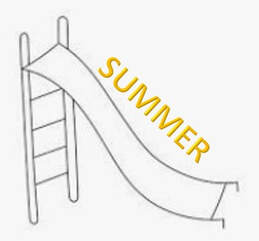 Summer holidays are soon upon us! Months of hard work will culminate in 10+ weeks of relaxation! A well-earned break is something that everyone looks forward to, but on the other side is something called SUMMER SLIDE! There are numerous studies that support the premise that students lose ground over the summer unless they engage in active learning activities several times a week. But have no fear – active learning does not always mean seat work or summer school. Active learning includes any and all activities that engage the brain in mental problem-solving! Here are some ideas you can implement to keep your children (and yourself) learning throughout the summer!
 Difficulty with attention and focus are common concerns that bring families to The Tutoring Center. Kids are busy and that is to be expected. They are full of both energy and emotion. Childhood is a time for imagination, fun, and play. Sitting in a classroom is not the most natural of environments and yet, most children, age 6-18 spend at least 30 hours per week doing just that. Many students struggle to maintain attention and focus at school and at home. When does this struggle cross the line and become an indicator of a more? Characteristics of Focus/Attention Issues □Overlooks or misses details, makes careless mistakes in schoolwork, at work, or during other activities □Has problems sustaining attention in tasks or play, including conversations, lectures, or lengthy reading □Does not seem to listen when spoken to directly □Does not follow through on instructions and fails to finish schoolwork, chores, or duties in the workplace or starts tasks but quickly loses focus and gets easily sidetracked □Has problems organizing tasks and activities, such as what to do in sequence, keeping materials and belongings in order, has messy work and poor time management, and fails to meet deadlines □Avoids or dislikes tasks that require sustained mental effort, such as schoolwork or homework, or for teens and older adults, preparing reports, completing forms or reviewing lengthy papers □Loses things necessary for tasks or activities, such as school supplies, pencils, books, tools, wallets, keys, paperwork, eyeglasses, and cell phones □Is easily distracted by unrelated thoughts or stimuli □Is forgetful in daily activities, such as chores, errands, returning calls, and keeping appointments Characteristics of Hyperactivity-Impulsivity □ Fidgets and squirms in their seats □ Leaves their seats in situations when staying seated is expected, such as in the classroom or in the office □ Runs or dashes around or climbs in situations where it is inappropriate or, in teens and adults, often feel restless □ Is unable to play or engages in hobbies quietly □ Is constantly in motion or “on the go,” or acts as if “driven by a motor” □ Talks nonstop □ Blurts out an answer before a question has been completed, finishes other people’s sentences, or speaks without waiting for a turn in conversation □ Has trouble waiting his or her turn □ Interrupts or intrudes on others, for example in conversations, games, or activities National Institute of Mental Health https://www.nimh.nih.gov It is normal to have some inattention, unfocused motor activity and impulsivity, but for people where these symptoms: -are more severe; -occur more often; -interfere with or reduce the quality of how they function socially, at school, or in a job THERE IS HELP! Reach out for more information and a no-obligation consultation. For more information reach out to Kelley Phipps at [email protected] |
Focus and Foundation
|
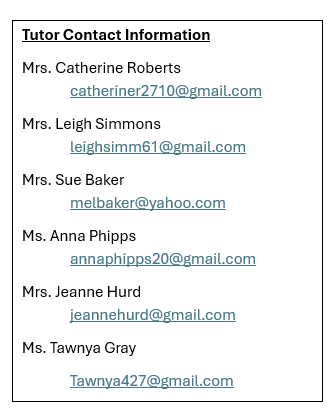
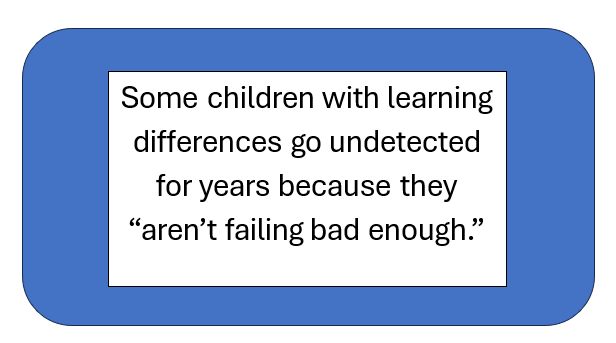
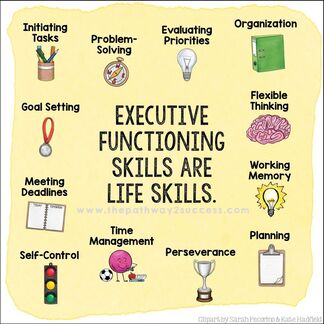
 RSS Feed
RSS Feed